Meta Description: Discover 22 amazing cotton swab art projects for kids! Easy crafts that develop fine motor skills, creativity, and learning. Perfect for home or classroom activities.
Keywords: cotton swab art projects, kids crafts, creative activities, fine motor skills, children’s art, Q-tip painting, educational crafts
Cotton swab art projects are taking the kids’ craft world by storm. And for good reason.
These simple tools can create amazing artwork. Your kids will love them. Plus, they’re perfect for developing fine motor skills.
In this guide, you’ll discover 22 creative cotton swab art projects. Each one is easy to make. And they’ll keep your children busy for hours.
Let’s dive in.
What Makes Cotton Swab Art So Special?
Cotton swab art isn’t just fun. It’s educational too.
Here’s why parents and teachers love these projects:
Fine Motor Skills Development: Gripping small cotton swabs helps kids build hand strength. This prepares them for writing and other tasks.
Creativity Boost: Kids can experiment with colors and patterns. There are no strict rules. This freedom sparks imagination.
Easy Setup: You need just a few supplies. Cotton swabs, paint, and paper. That’s it.
Low Mess: Unlike finger painting, cotton swab art stays contained. Less cleanup for parents.
Affordable: Cotton swabs cost very little. Most families already have them at home.
Skill Building: These projects teach color mixing, pattern recognition, and concentration.
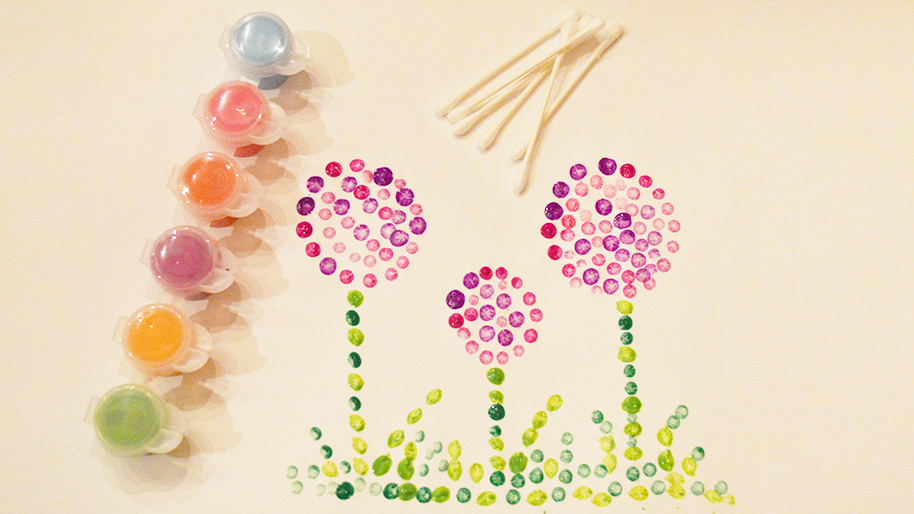
Cotton swab pointillism helps kids learn about color and technique
Essential Supplies for Cotton Swab Art
Before we start the projects, let’s gather supplies. You don’t need much:
Basic Supplies:
- SWABMASTERS cotton swabs (high quality tips work best)
- Washable tempera paint or watercolors
- Paper (construction paper, cardstock, or canvas)
- Paper plates for paint palettes
- Water cups for cleaning
- Paper towels
- Aprons or old clothes
Optional Supplies:
- Glue sticks
- Markers or crayons for outlines
- Colored paper
- Scissors
- Stencils or templates

High-quality SWABMASTERS cotton swabs with art supplies ready for creative projects

Children enjoying cotton swab art projects with flowers and trees
Now let’s explore the projects.
Seasonal Cotton Swab Art Projects
Spring Projects
1. Cotton Swab Flower Garden
Spring means flowers everywhere. This project brings that beauty indoors.
What you need:
- Green and colorful paint
- White paper
- SWABMASTERS cotton swabs
How to make it:
Start with green paint for stems. Dip your cotton swab and draw lines upward. Then switch to bright colors. Dab the cotton swab to make flower petals. Use different colors for variety.
Kids love this project because they can make their own garden. Each flower can be unique.
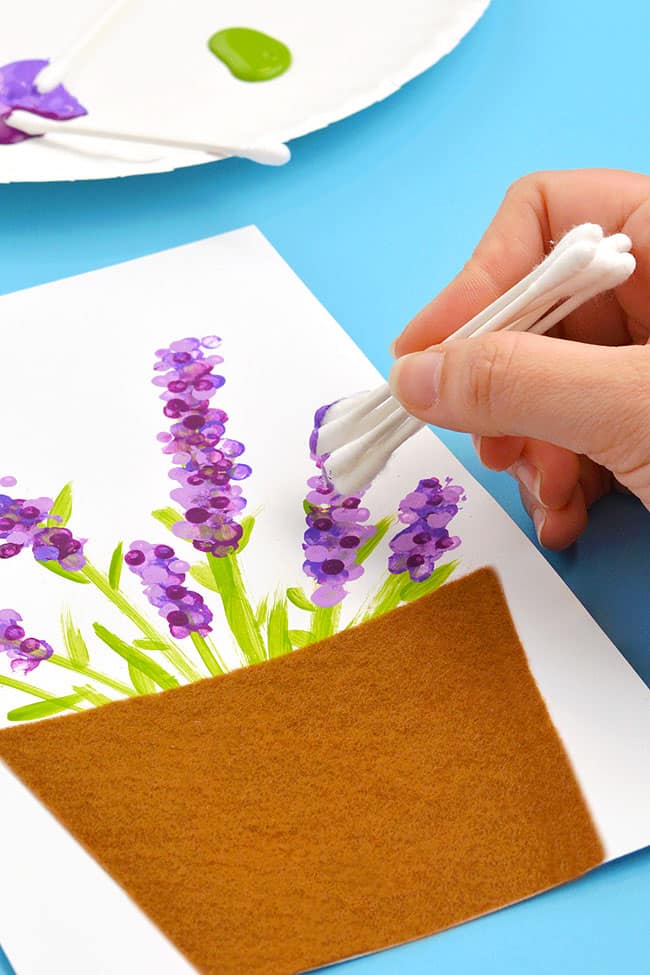
Bright flowers made with cotton swab dotting technique
2. Cotton Swab Dandelion Art
Dandelions are perfect for cotton swab art. The fluffy seeds look just like cotton swab tips.
What you need:
- Yellow and white paint
- Green paint for stems
- Blue paper for sky background
How to make it:
Paint a green stem first. Then dip cotton swabs in white paint. Press them around the stem top to make the fluffy dandelion head. Add some floating seeds by dabbing white paint across the paper.
This project teaches kids about nature. They learn how dandelion seeds spread in the wind.
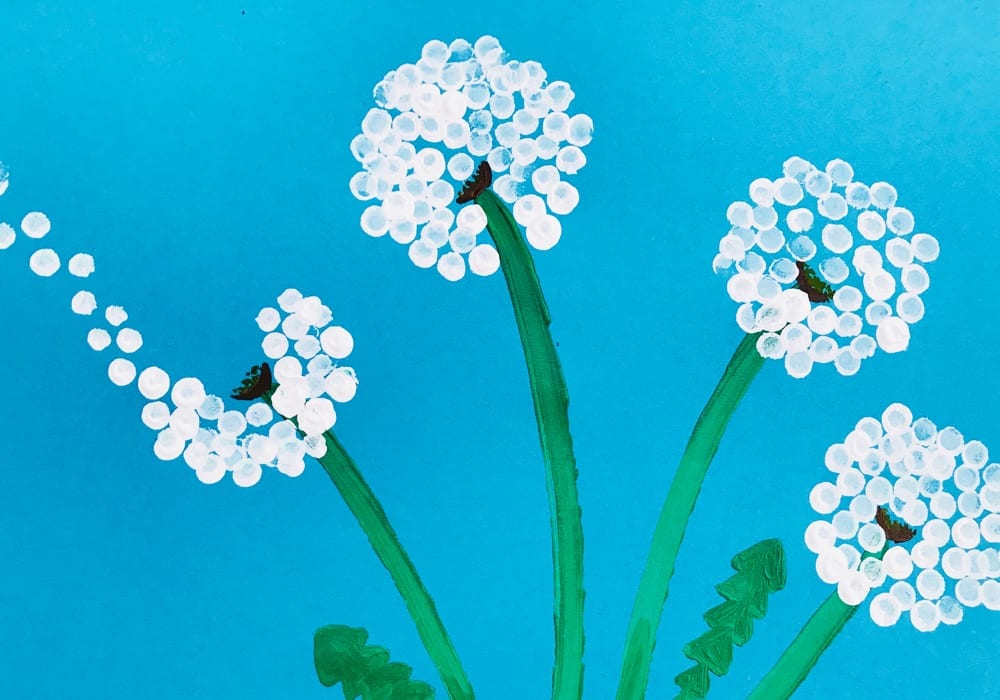
Realistic dandelions created with cotton swab technique
3. Cotton Swab Cherry Blossoms
Cherry blossoms are beautiful spring flowers. This project captures their delicate beauty.
What you need:
- Pink and white paint
- Brown paint for branches
- Light blue or white paper
How to make it:
First, paint brown branches with a brush. Let them dry. Then use cotton swabs with pink and white paint. Dab gently along the branches to create clusters of blossoms.
This project works great for learning about different cultures. Cherry blossoms are important in Japanese culture.
Summer Projects
4. Cotton Swab Fireworks
Summer means fireworks displays. Kids can create their own with cotton swabs.
What you need:
- Bright colors (red, blue, yellow, green)
- Black paper for night sky
- Glitter (optional)
How to make it:
Start from the center of your firework. Dip cotton swabs in bright paint. Make lines radiating outward like firework bursts. Use different colors for each firework. Add glitter while paint is wet for extra sparkle.
Kids love the dramatic effect on black paper. The bright colors really pop.
5. Cotton Swab Ice Cream Cones
Nothing says summer like ice cream. This project is sweet and simple.
What you need:
- Brown paint for cones
- Pastel colors for ice cream
- White paper
How to make it:
Draw triangle shapes for cones with brown paint. Then use cotton swabs to dab colorful “scoops” above each cone. Mix colors to create different flavors. Add sprinkles with tiny dots.
This project is perfect for discussing favorite flavors and colors.
6. Cotton Swab Butterfly Wings
Butterflies are everywhere in summer. This project captures their colorful wings.
What you need:
- Bright paint colors
- Black marker for body
- White paper
How to make it:
Fold paper in half. Open it and draw a butterfly body down the center with marker. Then use cotton swabs to dab colorful patterns on one wing. Fold the paper while paint is wet to transfer the pattern to the other wing.
This creates perfect symmetry. Kids learn about butterfly wing patterns.
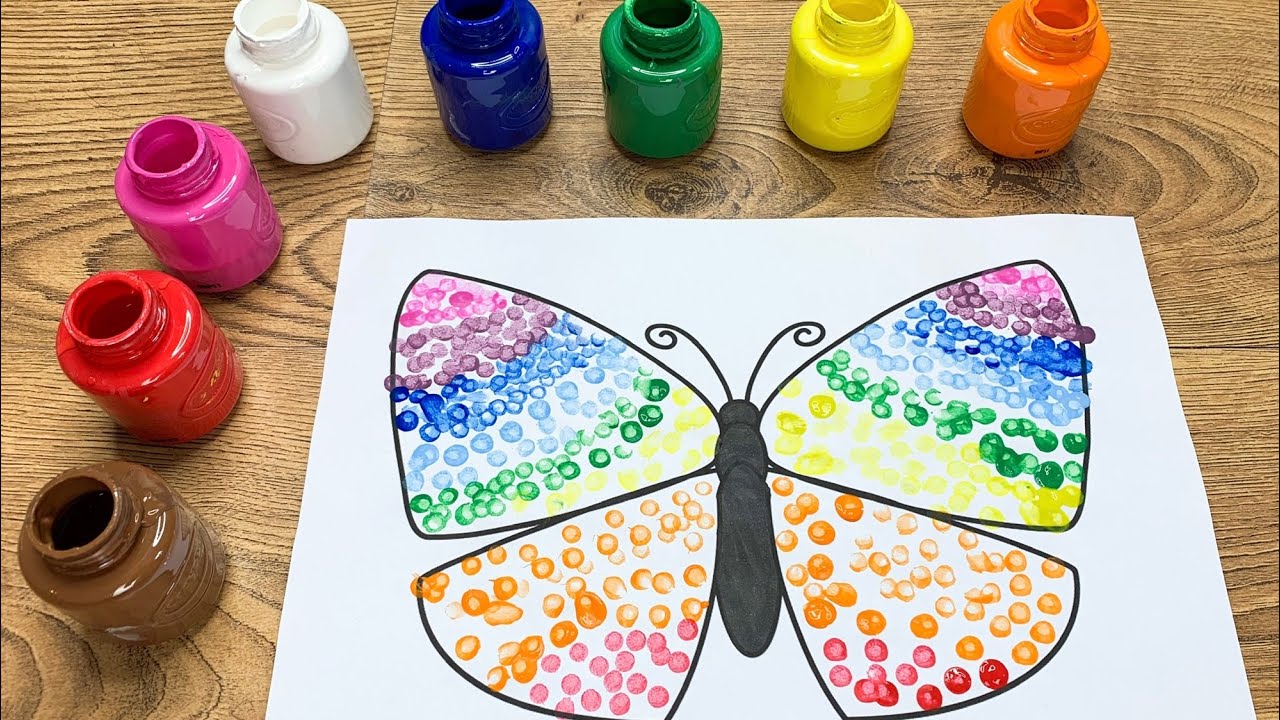
Colorful butterfly created with cotton swab dotting
Fall Projects
7. Cotton Swab Autumn Trees
Fall trees with changing leaves make beautiful art projects.
What you need:
- Brown paint for trunk
- Red, orange, yellow paint for leaves
- Blue paper for sky
How to make it:
Paint a brown tree trunk and branches first. Let dry completely. Then use cotton swabs with fall colors. Dab leaves all over the branches and some falling to the ground.
This project teaches about seasonal changes. Kids learn why leaves change color.

Beautiful autumn tree with cotton swab leaves
8. Cotton Swab Pumpkin Patch
Pumpkins are perfect for fall cotton swab art.
What you need:
- Orange paint
- Green paint for stems
- Brown paint for ground
How to make it:
Use cotton swabs to create round pumpkin shapes with orange paint. Make them different sizes. Add green stems on top. Create a brown ground line with scattered leaves.
Kids can make their own pumpkin patch. Each pumpkin can be unique.
9. Cotton Swab Corn Maze
Corn mazes are popular fall activities. This project brings them to paper.
What you need:
- Yellow paint
- Green paint
- Brown paper
How to make it:
Use cotton swabs with yellow paint to create corn kernels in rows. Make the rows curve like maze paths. Add green leaves at the top of each corn stalk.
This project combines art with problem-solving as kids design their maze paths.
Winter Projects
10. Cotton Swab Snowflakes
Snowflakes are perfect for cotton swab art. Each one can be unique.
What you need:
- White paint
- Dark blue or black paper
- SWABMASTERS cotton swabs
How to make it:
Start with a center dot of white paint. Then create six lines radiating out like spokes. Add smaller lines and dots to create intricate patterns. No two snowflakes should look the same.
This project teaches about symmetry and patterns in nature.
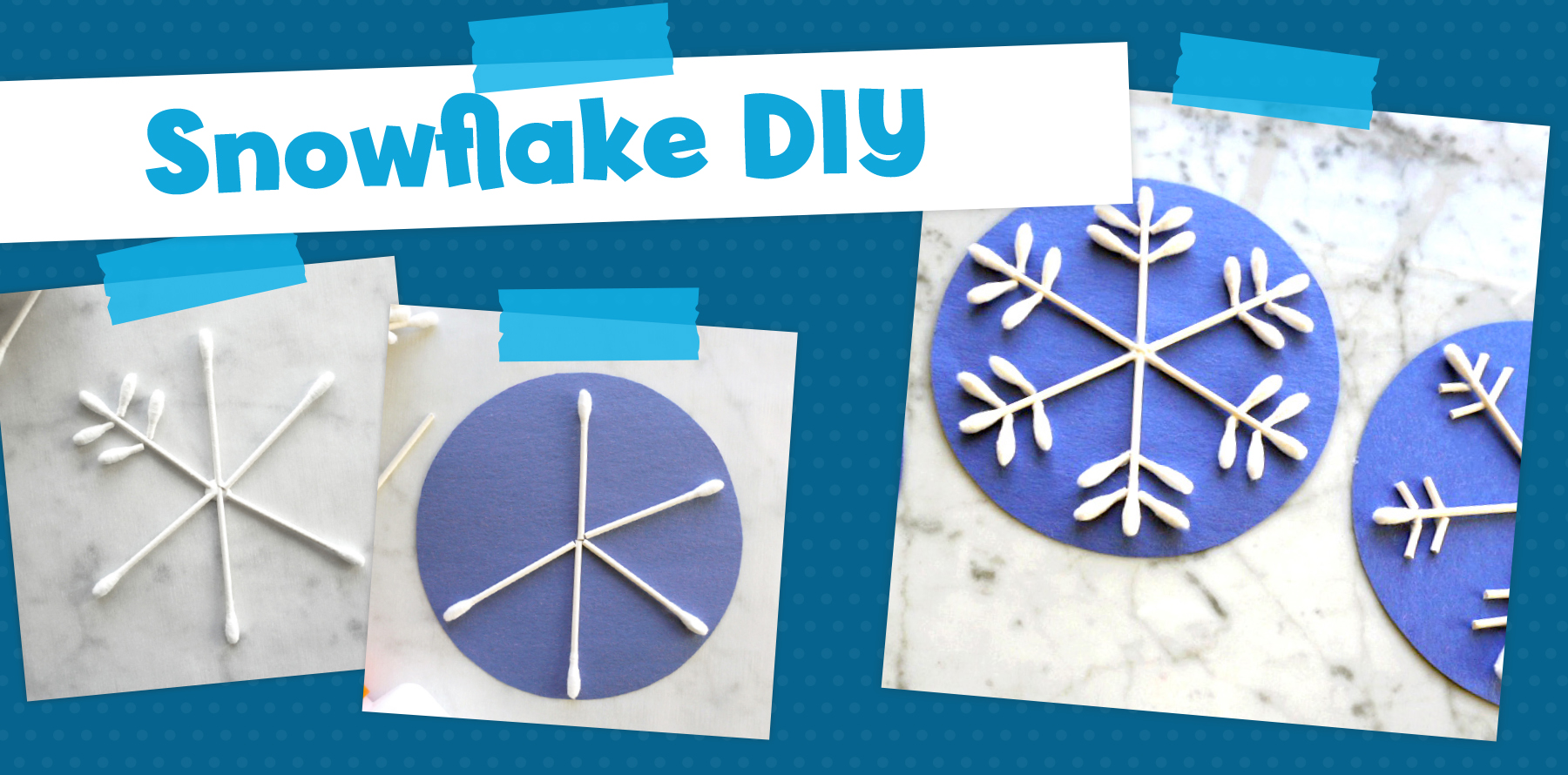
Delicate snowflakes made with cotton swab technique
11. Cotton Swab Winter Trees
Winter trees have a stark beauty. This project captures that mood.
What you need:
- Black or brown paint for branches
- White paint for snow
- Gray or blue paper
How to make it:
Paint bare tree branches first. Let dry. Then use cotton swabs with white paint to add snow on the branches and ground. Create a winter wonderland scene.
Kids learn about how trees look different in winter without leaves.
12. Cotton Swab Hot Chocolate
Warm drinks are perfect for cold winter days.
What you need:
- Brown paint for chocolate
- White paint for marshmallows
- Paper cups drawn on paper
How to make it:
Draw or paint cup shapes. Fill them with brown cotton swab dots for hot chocolate. Add white cotton swab dots on top for marshmallows. Draw steam lines rising up.
This project is cozy and warm. Perfect for winter craft time.
Holiday Cotton Swab Art Projects
Halloween Projects
13. Cotton Swab Skeleton
Halloween skeletons are spooky and fun. Cotton swabs make perfect bones.
What you need:
- White cotton swabs
- Black paper
- Glue
- Skull template (optional)
How to make it:
Draw or print a skull shape. Glue it to black paper. Then use cotton swabs to create the skeleton body. Break swabs in half for shorter bones. Arrange them like a real skeleton.
This project teaches basic anatomy. Kids learn about bones and body structure.
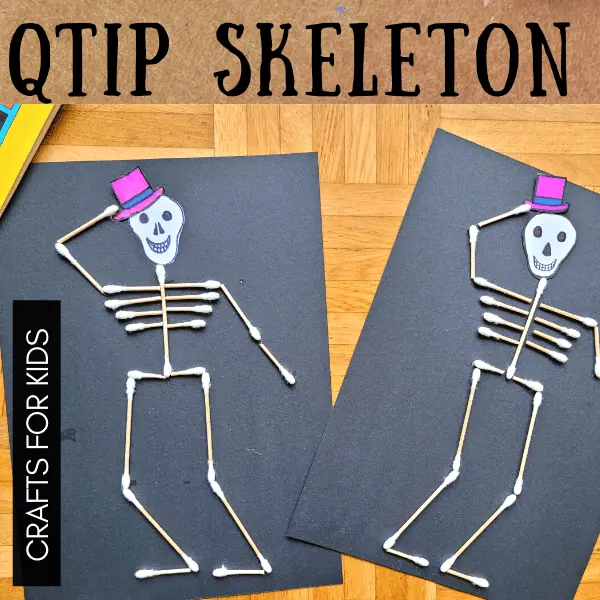
Spooky skeleton made entirely from cotton swabs
14. Cotton Swab Spider Web
Spider webs are classic Halloween decorations.
What you need:
- White paint
- Black paper
- Cotton swabs
How to make it:
Start with intersecting lines to create the web frame. Then use cotton swabs to add the circular web lines. Make some lines thicker than others for a realistic look.
Kids learn about spider web patterns and geometry.
Christmas Projects
15. Cotton Swab Christmas Trees
Christmas trees are perfect for cotton swab art.
What you need:
- Green paint
- Brown paint for trunk
- Colorful paint for ornaments
- White paper
How to make it:
Use cotton swabs to create triangular tree shapes with green dots. Add a brown trunk at the bottom. Then add colorful ornament dots throughout the tree. Top with a yellow star.
Each tree can be decorated differently. Kids can make a whole forest.

Beautiful Christmas tree created with cotton swab dotting technique
16. Cotton Swab Candy Canes
Candy canes are sweet Christmas symbols.
What you need:
- Red and white paint
- Paper
How to make it:
Use cotton swabs to create curved candy cane shapes. Alternate red and white stripes. Make them different sizes for variety.
This project teaches about patterns and shapes.
Educational Cotton Swab Art Projects
Learning Letters and Numbers
17. Cotton Swab Alphabet Art
Learning letters is more fun with art.
What you need:
- Various paint colors
- Paper with letter outlines
- SWABMASTERS cotton swabs
How to make it:
Draw large letter shapes on paper. Have kids fill them in with cotton swab dots. Use different colors for each letter. This helps with letter recognition and fine motor skills.
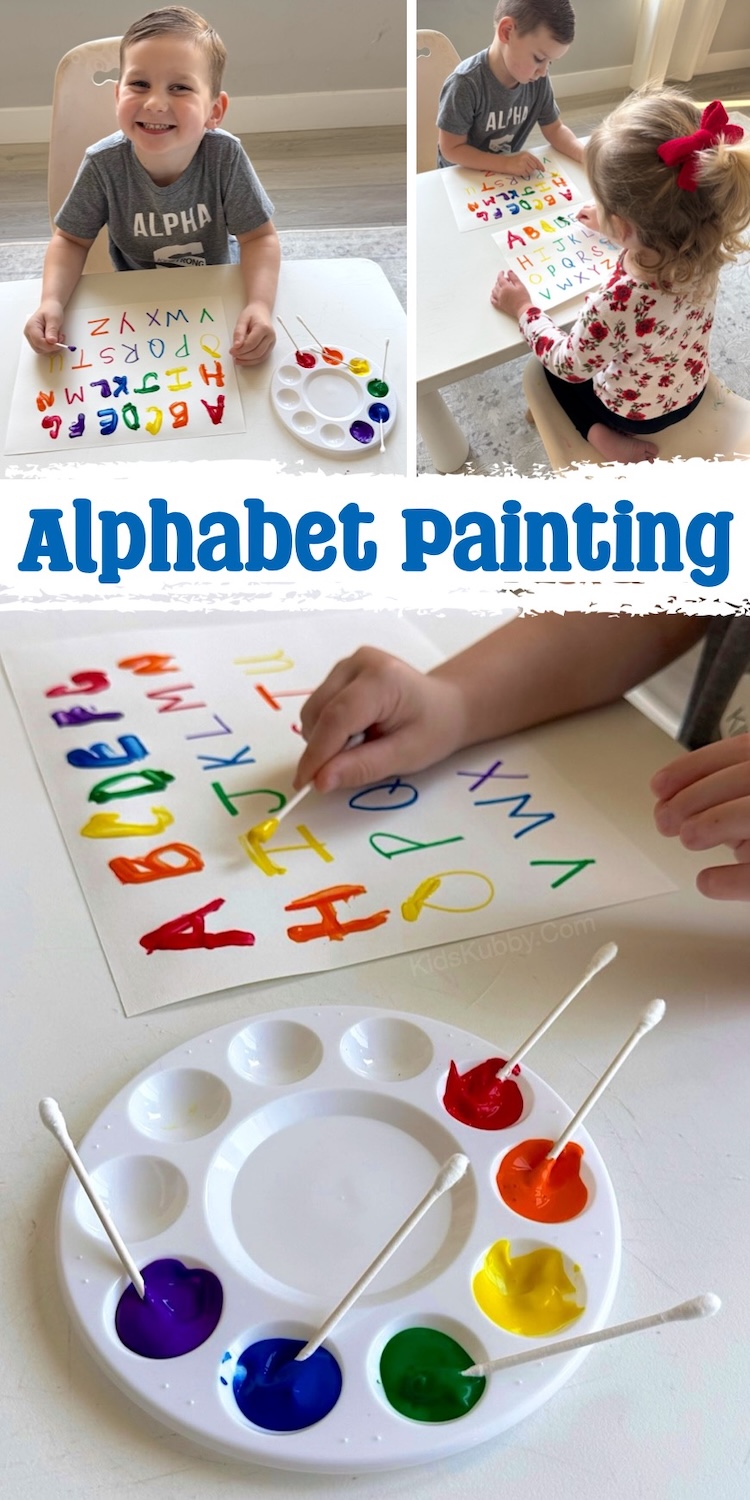
Colorful alphabet letters filled with cotton swab dots
18. Cotton Swab Number Practice
Numbers can be artistic too.
What you need:
- Paint in rainbow colors
- Number templates
- Cotton swabs
How to make it:
Create large number outlines. Kids fill them with colorful dots using cotton swabs. Count the dots as you go. This combines art with math learning.
Science Projects
19. Cotton Swab Color Mixing
This project teaches color theory.
What you need:
- Primary colors (red, blue, yellow)
- White paper
- Cotton swabs
How to make it:
Start with primary color dots. Then use clean cotton swabs to blend colors where they meet. Watch secondary colors appear. Red and blue make purple. Blue and yellow make green.
Kids learn how colors work together. This is basic color theory in action.
20. Cotton Swab Rainbow
Rainbows teach color order and weather science.
What you need:
- Rainbow colors in order
- Blue paper for sky
- Cotton swabs
How to make it:
Create rainbow arcs using cotton swabs. Follow the correct color order: red, orange, yellow, green, blue, indigo, violet. Add clouds at each end.
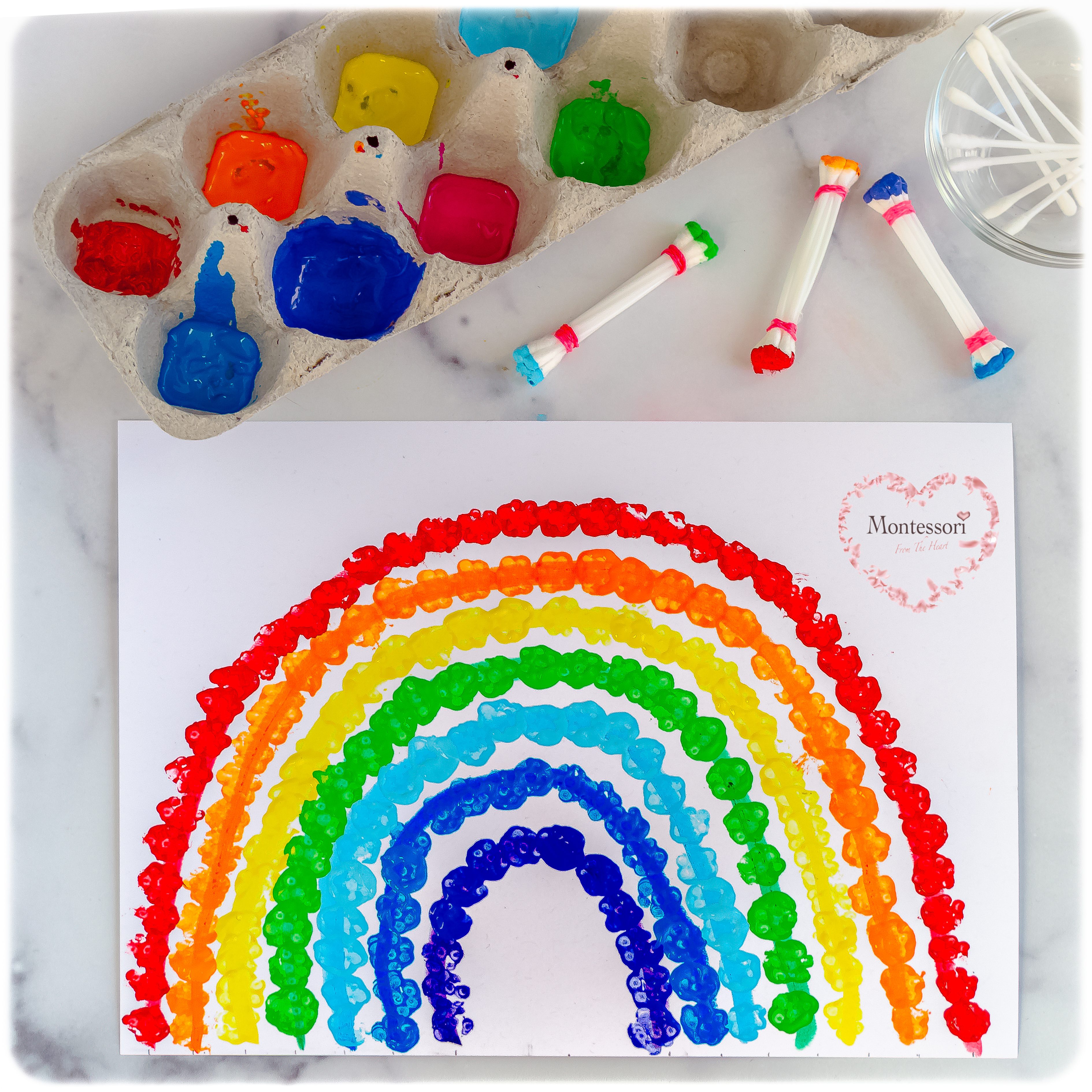
Perfect rainbow created with cotton swab technique
Advanced Cotton Swab Art Techniques
Pointillism Projects
21. Cotton Swab Pointillism Portrait
Pointillism is an advanced art technique. Cotton swabs make it accessible for kids.
What you need:
- Many paint colors
- Canvas or thick paper
- Cotton swabs
- Simple portrait outline
How to make it:
Start with a basic face outline. Use cotton swabs to fill in with tiny dots of color. Place warm colors (reds, oranges) for skin tones. Use cool colors (blues, purples) for shadows.
This project introduces famous art techniques. Kids learn about Georges Seurat and other pointillist artists.
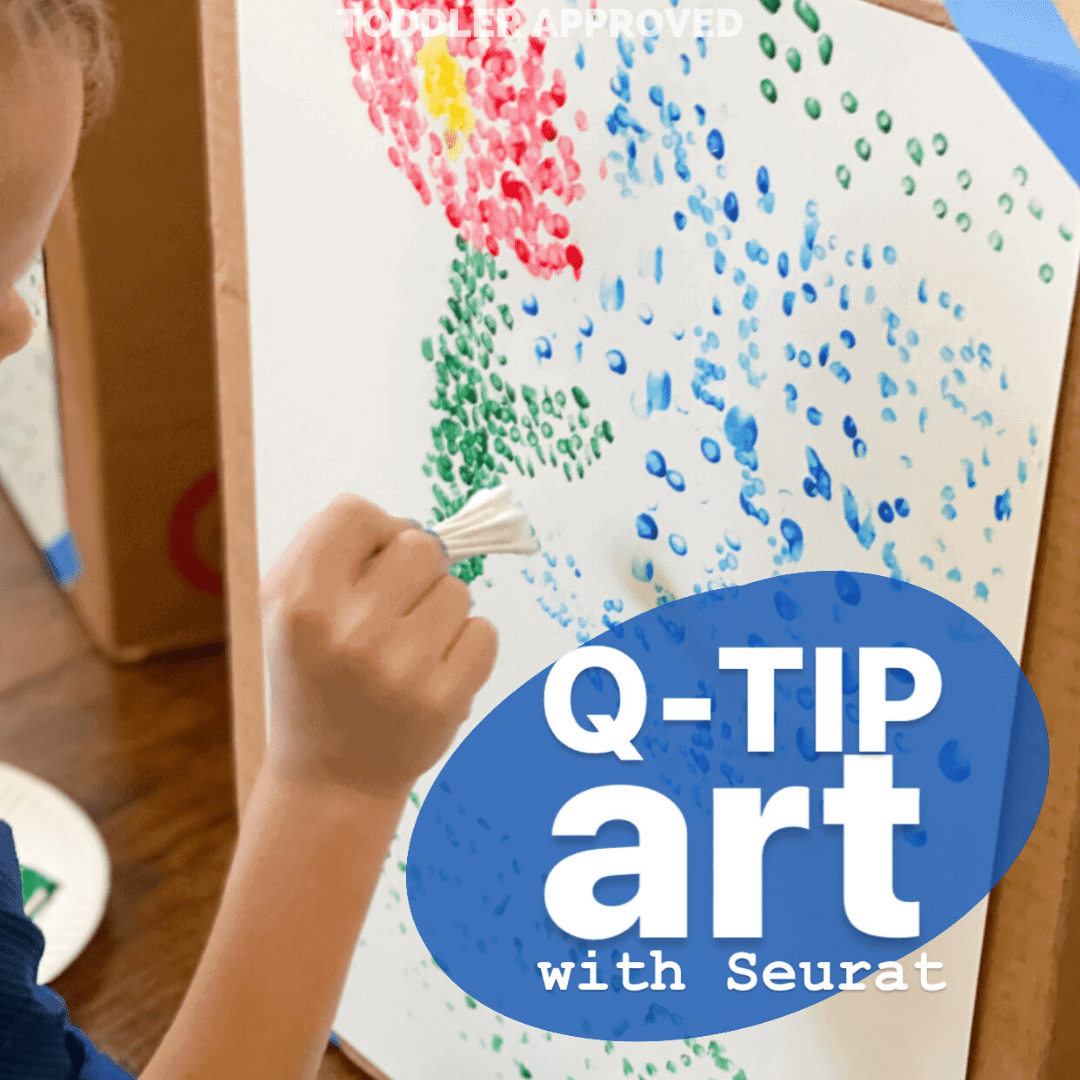
Pointillism technique using cotton swabs
22. Cotton Swab Landscape
Landscapes are perfect for practicing different techniques.
What you need:
- Various paint colors
- Large paper
- Cotton swabs
- Reference photo (optional)
How to make it:
Create a landscape scene using only cotton swab dots. Use different colors for sky, mountains, trees, and grass. Vary dot sizes for texture. Smaller dots for distant objects, larger dots for close objects.
This final project combines all the skills learned from previous projects.
Tips for Success with Cotton Swab Art
Choose Quality Cotton Swabs: SWABMASTERS cotton swabs have sturdy tips that won’t fall off during painting. This prevents frustration and creates better results.
Use the Right Paint: Washable tempera paint works best. It’s safe for kids and cleans up easily. Avoid watercolors for beginners as they’re harder to control.
Prepare Your Workspace: Cover tables with newspaper or plastic. Have water cups and paper towels ready. This makes cleanup much easier.
Start Simple: Begin with basic projects like flowers or trees. Build skills before attempting complex pointillism projects.
Let Kids Experiment: Don’t worry about perfect results. The process is more important than the final product. Let creativity flow.
Display the Artwork: Show off finished projects. This builds confidence and pride in their work.
Benefits Beyond Art
Cotton swab art projects offer many benefits:
Fine Motor Development: Gripping small cotton swabs strengthens hand muscles. This prepares kids for writing and other detailed tasks.
Hand-Eye Coordination: Placing dots precisely improves coordination. This skill transfers to many other activities.
Concentration Skills: These projects require focus and attention. Kids learn to concentrate for longer periods.
Color Recognition: Working with different colors improves color identification and vocabulary.
Pattern Recognition: Many projects involve creating or following patterns. This builds important math skills.
Following Directions: Step-by-step projects teach kids to follow instructions carefully.
Patience and Persistence: Some projects take time to complete. Kids learn to stick with tasks until finished.
Conclusion
Cotton swab art projects are amazing tools for creativity and learning. They’re simple to set up, affordable, and educational. Your kids will love creating beautiful artwork while developing important skills.
Start with simple projects like flowers or trees. Build confidence before moving to advanced techniques like pointillism. Remember, the goal is fun and learning, not perfection.
With SWABMASTERS cotton swabs and these 22 creative projects, you have everything needed for hours of artistic fun. Your kids will amaze you with their creativity and skill development.
So gather your supplies and start creating. The world of cotton swab art awaits!
Quick Reference: All 22 Cotton Swab Art Projects
| Project Name | Season/Theme | Difficulty | Age Range | Skills Developed |
|---|---|---|---|---|
| Cotton Swab Flower Garden | Spring | Easy | 3-8 years | Color recognition, creativity |
| Cotton Swab Dandelion Art | Spring | Easy | 4-10 years | Nature awareness, fine motor |
| Cotton Swab Cherry Blossoms | Spring | Medium | 5-12 years | Cultural learning, patience |
| Cotton Swab Fireworks | Summer | Easy | 4-10 years | Color mixing, creativity |
| Cotton Swab Ice Cream Cones | Summer | Easy | 3-8 years | Shape recognition, fun |
| Cotton Swab Butterfly Wings | Summer | Medium | 5-12 years | Symmetry, pattern recognition |
| Cotton Swab Autumn Trees | Fall | Easy | 4-10 years | Seasonal awareness, colors |
| Cotton Swab Pumpkin Patch | Fall | Easy | 3-8 years | Shape recognition, creativity |
| Cotton Swab Corn Maze | Fall | Medium | 6-12 years | Problem solving, patterns |
| Cotton Swab Snowflakes | Winter | Medium | 5-12 years | Symmetry, uniqueness |
| Cotton Swab Winter Trees | Winter | Easy | 4-10 years | Seasonal changes, observation |
| Cotton Swab Hot Chocolate | Winter | Easy | 3-8 years | Cozy themes, creativity |
| Cotton Swab Skeleton | Halloween | Medium | 6-12 years | Anatomy, following directions |
| Cotton Swab Spider Web | Halloween | Medium | 5-12 years | Geometry, patterns |
| Cotton Swab Christmas Trees | Christmas | Easy | 3-10 years | Holiday traditions, decoration |
| Cotton Swab Candy Canes | Christmas | Easy | 3-8 years | Patterns, shapes |
| Cotton Swab Alphabet Art | Educational | Easy | 4-8 years | Letter recognition, literacy |
| Cotton Swab Number Practice | Educational | Easy | 4-8 years | Number recognition, counting |
| Cotton Swab Color Mixing | Science | Medium | 5-12 years | Color theory, experimentation |
| Cotton Swab Rainbow | Science | Easy | 4-10 years | Color order, weather science |
| Cotton Swab Pointillism Portrait | Advanced | Hard | 8-15 years | Art history, technique |
| Cotton Swab Landscape | Advanced | Hard | 8-15 years | Perspective, composition |
Frequently Asked Questions
Q: What age is best for cotton swab art projects?
A: Cotton swab art works for ages 3-15. Younger kids (3-6) enjoy simple dotting projects. Older kids (7-15) can handle complex techniques like pointillism. Always supervise young children with small parts.
Q: Are cotton swab art projects messy?
A: These projects are much less messy than finger painting. Cotton swabs contain the paint better than brushes. Use washable tempera paint and cover work surfaces for easy cleanup.
Q: How long do cotton swab art projects take?
A: Simple projects take 15-30 minutes. Complex projects like pointillism portraits can take 1-2 hours. Plan based on your child’s attention span and interest level.
Q: Can I use regular cotton swabs or do I need special ones?
A: SWABMASTERS cotton swabs work best because they have sturdy tips that won’t fall off. Regular cotton swabs can work but may be frustrating if tips come loose during painting.
Q: What type of paint works best?
A: Washable tempera paint is ideal. It’s safe, vibrant, and cleans up easily. Avoid watercolors for beginners as they’re harder to control with cotton swabs.
Q: How do I store cotton swab artwork?
A: Let artwork dry completely before storing. Use a flat portfolio or art folder to prevent smudging. Display finished pieces to build your child’s confidence and pride.
Q: Can these projects be done in classrooms?
A: Absolutely! Cotton swab art is perfect for classrooms. It’s contained, educational, and develops multiple skills. Teachers love these projects for art centers and integrated learning.
Q: How do I encourage reluctant artists?
A: Start with simple, fun projects like ice cream cones or flowers. Focus on the process, not perfection. Praise effort and creativity. Let kids choose their own colors and designs.
Safety Tips for Cotton Swab Art
Supervision Required: Always supervise young children. Cotton swabs have small parts that could be choking hazards for children under 3.
Non-Toxic Materials: Use only non-toxic, washable paints. Check labels to ensure safety for your child’s age group.
Proper Ventilation: Work in well-ventilated areas, especially with acrylic paints. Open windows or work outdoors when possible.
Clean Hands: Wash hands before and after art projects. This prevents paint ingestion and keeps artwork clean.
Eye Protection: Teach children not to point cotton swabs toward faces. Paint can splash unexpectedly.
Allergy Awareness: Check for latex allergies if using latex-based paints. Some children may be sensitive to certain paint ingredients.
Adapting Projects for Different Abilities
For Younger Children (Ages 3-5):
- Use larger cotton swabs for easier gripping
- Provide fewer color choices to prevent overwhelm
- Focus on simple shapes and patterns
- Offer lots of encouragement and praise
For Children with Fine Motor Challenges:
- Use adaptive grips on cotton swab handles
- Provide hand-over-hand guidance initially
- Choose projects with larger target areas
- Allow extra time for completion
For Advanced Young Artists:
- Introduce color theory concepts
- Discuss famous pointillist artists
- Encourage experimentation with techniques
- Provide constructive feedback on composition
Extending the Learning
Science Connections:
- Discuss how paint mixes to create new colors
- Explore symmetry in nature (butterflies, snowflakes)
- Learn about seasonal changes through themed projects
- Study famous artists who used similar techniques
Math Integration:
- Count dots in patterns
- Practice shape recognition
- Explore symmetry and geometry
- Measure and compare artwork sizes
Language Arts Links:
- Write stories about artwork
- Learn vocabulary related to colors and art
- Practice following step-by-step directions
- Describe artwork using descriptive language
Cultural Studies:
- Explore art from different cultures
- Learn about holiday traditions through themed projects
- Discuss the history of pointillism
- Compare art styles from various countries
Building an Art Portfolio
Documentation: Take photos of each project with the date and child’s age. This creates a wonderful record of artistic development over time.
Display Options: Create a rotating gallery wall at home. Change displays monthly to keep interest high and show progress.
Art Journals: Keep a simple journal with each project. Include the child’s comments about their artwork and what they learned.
Sharing Success: Share artwork with grandparents, teachers, and friends. This builds confidence and pride in creative accomplishments.
Conclusion: The Magic of Cotton Swab Art
Cotton swab art projects offer incredible value for children’s development. These simple tools create amazing results while building essential skills. From fine motor development to creativity and concentration, the benefits extend far beyond the artwork itself.
The 22 projects in this guide provide months of creative activities. Start with simple seasonal projects and gradually introduce more complex techniques. Remember that the process matters more than the final product. Encourage experimentation, celebrate creativity, and enjoy the magical moments of artistic discovery.
With SWABMASTERS cotton swabs and these proven project ideas, you have everything needed to inspire young artists. Watch as your children develop confidence, skills, and a lifelong love of creative expression through the simple joy of cotton swab art.
Whether you’re a parent looking for engaging home activities or a teacher seeking classroom projects, these cotton swab art ideas will amaze and delight children of all ages. The combination of simplicity, creativity, and skill development makes cotton swab art an invaluable addition to any child’s artistic journey.
Start your cotton swab art adventure today and discover the incredible creativity that awaits!


